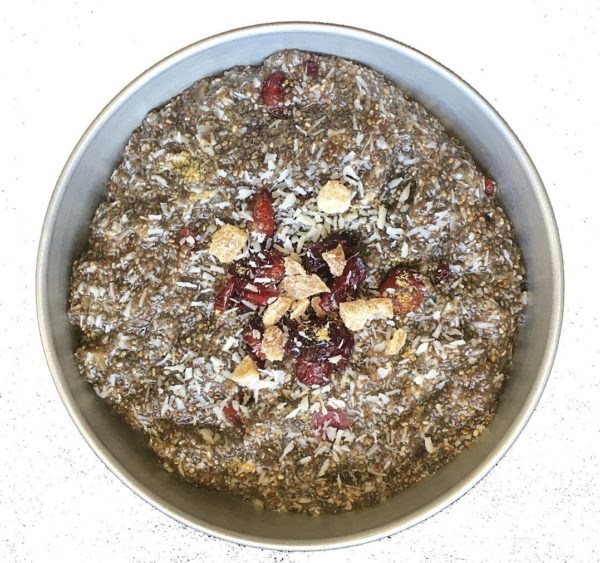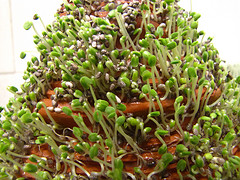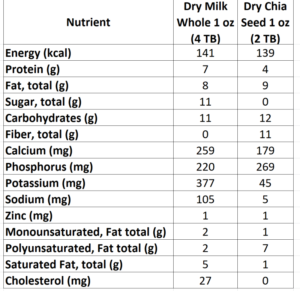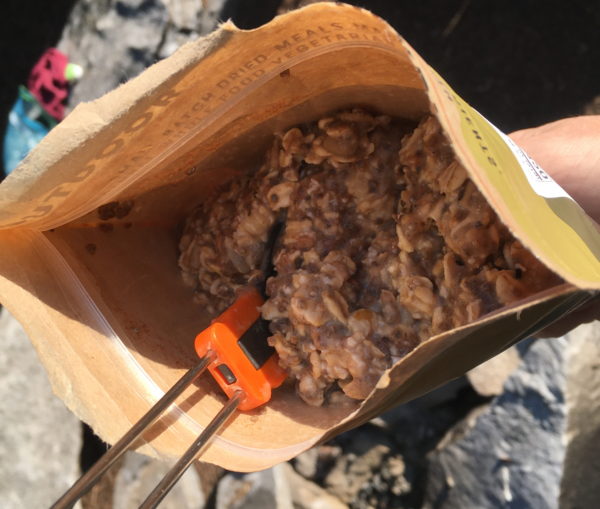Chia seeds offer extensive value for the lightweight backpacker. Here’s why:
- Tiny and lightweight with a storage life of up to 5 years.
- Require no cooking. Chia seeds are great for making cold-soaked pudding, cereal, or smoothies.
- Chia Seed High Energy Content: 140 Calories per 1.0 oz (28.35 g) or 2 TB.
- Have a good nutrient profile with omega-3 fat, dietary fiber, phosphorous, and calcium.

How to Eat Chia
You can eat chia seeds by cold soaking them in water, sprinkling them on oats and other meals, or sprouting them. To hydrate the seeds to make a pudding, add 1 part chia to 4 parts water and rest for 10 minutes. The seeds will soften and form a gel-like consistency after soaking in water.

Chia is a Hiking Superfood

Thanks to the popularity of the sprouted “Chia Pet” clay planter, many of us are familiar with chia. But chia seed warrants a reputation as a superfood instead of a lowly sprouted window ornament.
Chia seeds are tiny (about 1-2 mm) and packed inside the amazingly minuscule seed are vital nutrients that provide sustained energy. The seeds are extremely rich in omega-3 fatty acids (approximately 64% of the oil) and have the highest antioxidant activity of any whole food known today. Chia helps to build muscle and tissue, prolong endurance, and provide extensive hydration due to its ability to absorb more than 12 times its weight in water. In fact, chia seed was one of the primary foods used by the Aztecs for hiking long distances.
Chia seed is gelatinous, producing an easily assimilable saccharide gel when exposed to water. The gelatinous characteristic benefits hikers by slowing the digestive process to provide an extended energy release. Some hikers report feeling a gentle “energy rush” from chia, much different than consuming energy drinks, caffeine, and supplements.
Storing Chia Seeds
Chia seeds can be stored for up to 5 years if kept dry and at room temperature. Due to the high level of antioxidants in chia, the seed will not turn rancid like other fatty seeds (such as flaxseed), lose flavor, or degrade in nutritional content. Clearly, chia seed serves as a powerful raw survival food.
Chia Seed in Trail Meals
Chia has a mild flavor, making it suitable to add to dishes without altering the taste. Sprinkle seeds on breakfast cereals or thicken liquids, shakes, puddings, soups, and sauces. Outdoor Herbivore offers several no-cook chia seed meals.

Chia Calcium Claims
Many websites claim chia has 3-5 times the calcium of milk, it does not. Nonetheless, chia is a good source of calcium.
Comparison of Chia Seed to Whole Powdered Cow’s Milk (1 Oz)
 Source of Data: http://ndb.nal.usda.gov/ndb/search/list
Source of Data: http://ndb.nal.usda.gov/ndb/search/list
NDB No: 12006
Chia seeds for Backpacking
Few raw foods contain the same amount of energy and nutrient content by weight as the chia seed. Try them for your next backpacking trip. They’ve become one of Outdoor Herbivore’s favorite backpacking food staples.

3 thoughts on “Chia Seeds: The Ultimate Backpacking Superfood”
Rosemary is the natural superfood that helps to reduce the symptoms of gout.
Thanks for the article very helpful. I have a question of using green or ripe bananas.
Technically speaking chia seeds is slightly good than milk in some nutritional factors. I love chia seeds and i am using it now.